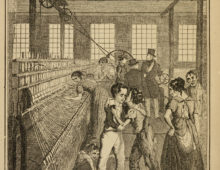Tagged with Women
Resource : The Rajah Quilt
Transportation was an extremely harsh punishment of the 1700s and 1800s, second only to execution. Between 1787 and 1852 as many as 25,000 women were transported from Britain to Australia to work in penal colonies, for crimes as varied as petty theft and poaching, to murder. Their sentences were often miscarriages of justice. Many didn’t survive the long journey. Most of them never returned. This remarkable quilt was made by women transported to Tasmania in 1841.
Resource : Portrait of Mary Wollstonecraft
Mary Wollstonecraft was a revolutionary writer who made a powerful case for educating and emancipating women. She is still regarded as one of the founders of modern British feminism.
Resource : Portrait of James Barry
Born Margaret Bulkley, James Barry lived most of his life as a man, qualifying as a doctor and becoming an accomplished and respected military surgeon. His identity as a woman was only revealed when his maid laid him out after his death. It is not known whether Barry identified as a man or whether he simply kept up a disguise in order to have a medical career, at a time when women were denied this opportunity.
Resource : Cotton kerchief (headwrap)
The headwrap originated in sub-Saharan Africa. For centuries, it has been worn by women in different African countries and regions, in different forms, to reflect both communal and personal identities – which clan or tribe they belonged to, whether they were married, widowed, young or old, for example. This cotton kerchief, or headwrap, belonged to Nancy Burns (1800 – 1849). Born in Albany, New York, the daughter of slaves, she would eventually find work as a house servant and was painted in a portrait wearing the item in the 1840s. It represents a long history of cultural identity associated with women of African origin – particularly African-American women – that is still very much alive today.
Resource : Brontë little books
The Brontës – Charlotte (1816-1855), Emily (1818-1849) and Anne (1820-1849), are the most famous sisters in English Literature. Their insightful, dramatic and often subversive novels, published in the mid 1800s, provide a unique window into the social conditions of the time. With unforgettable characters like Jane Eyre and Heathcliff, and themes which are still highly relevant today, their stories have become classics and been adapted over and over again for stage and screen.
Resource : Laffayette orange peel quilt
Quilting has a long history in North America, dating back to the early colonial settlers of the 1600s and bringing together different ethnic and cultural traditions. As well as their practical use for warmth, they were made – often communally – to mark important family occasions such as weddings and births. As quilt-making developed from a practical necessity into skilled folk artistry, different patterns and symbols emerged carrying different meanings. This classic ‘orange peel’ design is said to have been influenced by Lafayette.
Resource : The Velocipede
Invented 200 years ago, the humble bicycle is one of the most popular and enduring innovations of all time. Relatively cheap and simple to produce, environmentally sound, easy and fun to use, great for keeping fit and available to people of all ages and from all walks of life, it is still a significant part of our lives today.
Resource : Tokens given by mothers to their children on leaving them at the Foundling Hospital
This is a selection of tokens from mothers who, unable to keep their babies, left them at the Foundling Hospital in London. They highlight the plight of single mothers and destitute families unable to care for their children and are a poignant reminder of the growing poverty crisis as cities became more heavily industrialised and workers more mobile during the Age of Revolution. Many babies were left anonymously by their mothers, along with a token to identify them, in the hope that they might be reunited in the future.
Resource : The Pussyhat
The Pussyhat project is a social movement focused on raising awareness about women’s issues and advancing human rights. Propelled by social media – a revolution in communications – the pussyhat has rapidly become an international symbol for women’s rights, political resistance and collective action.
Resource : Portrait of Elizabeth Fry
Elizabeth Gurney Fry (1780 – 1845) was a social reformer, best remembered for her work improving conditions for people in prison. She was the first female prison reformer in Europe, and probably the best known of her time. She became known as ‘the angel of the prisons.’


